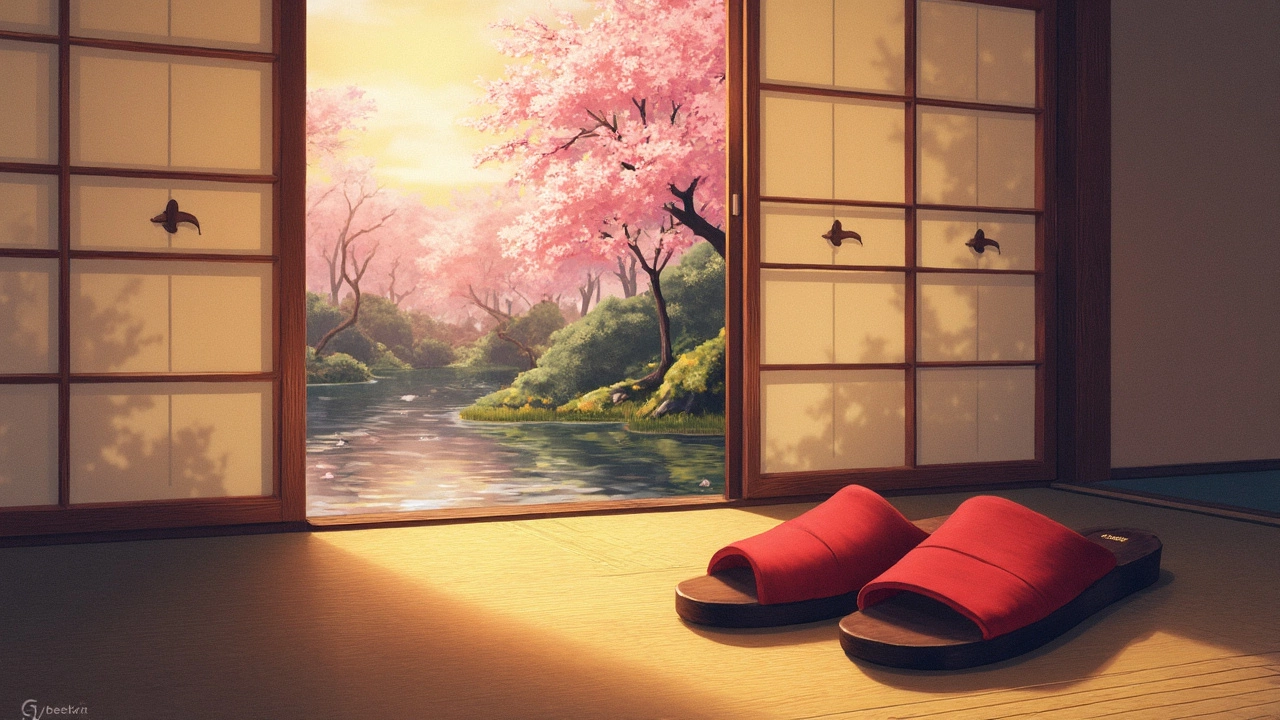Exploring the World of Japanese Slippers: Geta, Zori, and More

When you think of Japanese slippers, images of colorful and quirky wooden styles might spring to mind. But did you know that these slippers are more than just unique footwear? They're steeped in tradition and serve specific purposes in Japanese culture.
For starters, there are various types of slippers in Japan, each with its own story. Take Geta, for example. These are those eye-catching wooden sandals you've probably seen in movies. They're not just for show—Geta are designed to keep kimonos off the ground and to navigate Japan's wet climate.
On the other hand, you have Zori, which are more like the flip-flops we wear at the beach, but with a twist. Traditionally made from rice straw, cloth, or leather, Zori are often worn with formal kimonos or during casual gatherings. They're all about mixing comfort with style.
Understanding these slippers isn't just about fashion. It involves diving into their history, the materials used, and the role they play in daily life. Whether you're planning a trip to Japan or curious about different cultures, these slippers offer a fascinating glimpse into Japanese lifestyle choices.
- Introduction to Japanese Slippers
- Geta: The Wooden Sandals
- Zori: Casual and Comfortable
- Cultural Significance of Japanese Slippers
- Choosing the Right Pair for You
Introduction to Japanese Slippers
So, what exactly are Japanese slippers? They're not just any regular footwear that you slip into at the end of a tiring day. These slippers have deep roots in Japanese history and are tied to cultural and practical aspects of everyday life.
Japanese slippers generally fall into two categories: indoor and outdoor. Indoor slippers, often called "uwabaki," are used within homes and schools, embodying the cultural emphasis on cleanliness. Outdoor slippers, like the renowned Geta and Zori, serve distinct purposes and styles.
The Purpose Behind Japanese Slippers
In Japan, it's customary to remove your shoes when entering a home. This is where slippers come in handy. It shows respect for the space, and keeps things tidy. You might even find separate bathroom slippers in some homes to avoid cross-contamination. It's a whole system!
Design and Materials
What makes Japanese slippers stand out is their design and craftsmanship. Geta, for instance, are crafted from wood and often feature raised platforms to help keep the foot above mud and rainwater. Zori, on the other hand, are usually made with rice straw or more modern materials like vinyl. They prioritize comfort and can be quite colorful or traditional, depending on the occasion.
If you ever find yourself in a Japanese home or a traditional inn (called a ryokan), you'll notice the warm welcome with slippers at the entryway. It's more than a tradition; it's a gesture of hospitality and cleanliness.
Geta: The Wooden Sandals
When it comes to traditional Japanese footwear, Geta are probably the most recognizable. Made from wood, these sandals are both practical and symbolic. You might be wondering why anyone would choose wooden footwear, but in Japan, there's a good reason.
First, let's talk about design. Geta usually have a wooden base with teeth-like extensions underneath, elevating the wearer from the ground. This might sound uncomfortable, but it helps keep the bottom of long kimonos dry and clean when the streets are wet.
History and Evolution
Geta have been around since ancient times. Initially, they were used by farmers or field workers needing to move through mud without soiling their clothes. Over time, they became popular in cities, making their way into everyday life. During festivals, you’ll often see people donning Geta as a nod to tradition.
Types of Geta
- Two-Toothed Geta: These are the most common, featuring two supporting blocks beneath the wooden platform. They’re great for strolling through streets or festivals.
- Single-Toothed Geta: Known as “tengu geta,” these are less common and more challenging to walk in, featuring just one raised block. They require balance and are often worn by performers for dramatic effect.
How to Wear Geta
Wearing Geta takes a bit of practice due to the elevated platform. Here are some tips if you're eager to give them a try:
- Select the Right Size: Make sure the base of the Geta matches the size of your foot. Unlike other shoes, they don’t come in half-sizes.
- Get Comfortable with Balancing: Start walking slowly on even ground to get used to the weight distribution.
- Pair with Traditional Wear: If you're wearing them with a kimono, you'll fit right into any Japanese cultural celebration.
Whether you're planning a trip or just love exploring unique cultures, understanding how and why the Japanese wear these wooden sandals offers a fascinating insight into their history and lifestyle.

Zori: Casual and Comfortable
Zori are a prime example of how traditional Japanese slippers blend style with practicality. They kind of resemble flip-flops but bring a touch more elegance and a hint of Japanese culture. Zori have a flat sole that makes them super comfy for daily wear, whether you're strolling through a serene garden or hitting a vibrant festival.
Let's break down the details, shall we? Unlike the hefty wooden Geta, Zori have a more flexible construction. They're traditionally made using rice straw, cloth, or leather, aligning with the simple yet effective design principles you often see in Japanese items.
Materials and Design
The construction isn't just about appearance—it's practical too. The soles of Zori are typically crafted to provide cushioning, which is why your feet will thank you after a day-long adventure. Plus, they're designed to be lightweight, allowing for easy movement and flexibility.
When to Wear Zori
While you can spot Zori at formal events, thanks to their polished look, they're also great for casual outings. You might wear them with a kimono at a summer festival or just with some comfy clothes on a sunny day.
One interesting aspect of Zori is their role in traditional ceremonies. They're usually paired with specific types of clothing like yukata or kimono, offering a seamless blend of comfort and tradition.
Tips for Choosing and Wearing Zori
If you're thinking of getting a pair, consider the material that suits your needs best. Rice straw is traditional and eco-friendly, while leather offers a more polished look.
- Make sure they fit snugly but not too tight—the thong strap should be comfortable between your toes.
- Go for a style that compliments your attire; traditional patterns add a dash of authenticity.
So whether you're looking for a bit of cultural infusion in your wardrobe or just seeking a comfy option for everyday wear, Zori offer a practical yet stylish choice.
Cultural Significance of Japanese Slippers
Japanese slippers aren't just about keeping your feet cozy; they carry deep cultural significance. For instance, in Japan, cleanliness is paramount, and slippers play a big role in maintaining this standard. When entering a Japanese home, it’s customary to remove your outdoor shoes and swap them for indoor slippers. This simple act speaks volumes about the cultural emphasis on separating the outside world from the purity of the home.
Shoes off, slippers on—this ritual doesn’t just apply at home. You’ll find it in schools, traditional inns called ryokan, and even some workplaces. There are special slippers for bathrooms too, highlighting the importance of hygiene and respect for private spaces.
Symbol of Respect and Tradition
Wearing Japanese slippers is also about respect. When visiting someone's home, following these customs shows your understanding and appreciation of their traditions. It's not just about practicality; it’s a nod to a way of life that values discipline and orderliness.
Geta and Zori in Cultural Ceremonies
Aside from daily use, slippers like Geta and Zori play a role in ceremonies and festivals. Zori, often paired with traditional attire, are seen at weddings and formal events. Meanwhile, Geta, with their distinctive clacking sound, are popular during summer festivals, keeping the spirit of ancient Japan alive.
Want a fun fact? There's even a slipper-shaped island called iIsland, shaped like a traditional Geta. It's one of those quirky cultural tidbits that make Japanese slippers much more than just something you slip on your feet.

Choosing the Right Pair for You
Deciding on the perfect pair of Japanese slippers might seem like a challenge, but once you know what you're looking for, it's a breeze. Here's how you can make sure you pick the right ones for your needs.
Nailing the Fit
First things first, comfort is key. When it comes to Zori, you want them to fit snug but not too tight. Your heel should rest comfortably within the edges of the strap. For Geta, it's important that the toes grip the sandal as you walk for stability.
Material Matters
Next, think about the material. If you're going for something authentic, look for Zori made from rice straw or cloth. These materials are perfect for casual, relaxed settings. For rainy days, you might want a waterproof version with synthetic materials.
- Geta: Preferably made from lightweight wood like paulownia. They're perfect for outdoor use.
- Zori: Often come with leather or vinyl straps for a dressy look.
Style and Purpose
Ask yourself, where will you wear these? If it's for a formal event, choose something stylish like a leather Zori. However, if you're planning to wear them around the house, go for comfort with a simple straw design.
Budgeting
Finally, consider your budget. Authentic materials can be a bit pricey, but their durability often makes up for it. For a more budget-friendly version, synthetic options work well without sacrificing style.
Here's a quick look at the price ranges you might encounter:
| Type | Material | Price Range (USD) |
|---|---|---|
| Geta | Wood | $30-100 |
| Zori | Straw/Cloth | $20-50 |
| Zori | Leather | $50-150 |
That's about it! Keep these points in mind, and you'll be stepping out in style and comfort with the perfect pair of Japanese slippers.